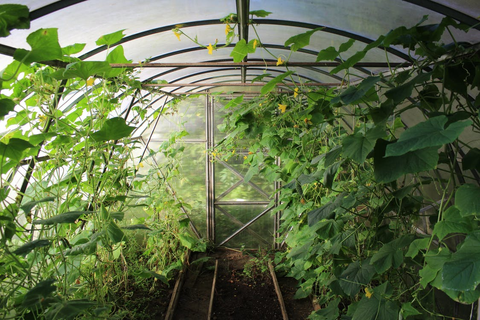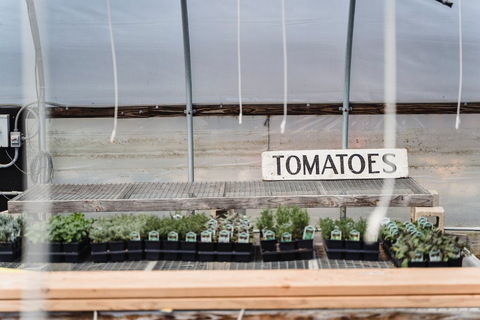
As the chilly winds of winter approach, many gardeners believe it's time to hang up their gardening gloves and wait for the warmth of spring. However, with the right knowledge and tools, you can continue to enjoy fresh, homegrown greens even in the coldest months.
In this comprehensive guide, we'll explore the art of growing greens in the winter season and how the right greenhouse and greenhouse accessories can make all the difference in maintaining a thriving winter garden.
Why Consider Growing Greens in Winter?
Before we dive into the specifics of winter gardening, let's understand why it's worth your time and effort:
- A Steady Supply of Fresh Greens: Growing your greens in winter ensures a consistent source of fresh and organic produce.You won't have to rely on store-bought options, which may have traveled long distances and lost some nutritional value.
- Extend the Growing Season:With the help of a well-equipped greenhouse, you can extend your growing season throughout the winter months. This means more time for gardening and a broader range of crops to enjoy.
- Control Over Growing Conditions: Winter gardening allows you to have complete control over temperature, humidity, and light levels. This level of control is vital for nurturing plants in harsh winter conditions.
- A Therapeutic Activity: Gardening can be therapeutic and provide a sense of accomplishment, even during the winter blues. It's a fantastic way to connect with nature and reduce stress.

Greens Suitable for Winter Gardening
Several cold-hardy greens thrive in winter conditions. Here are some popular choices:
- Kale: Kale is incredibly hardy and can withstand frost. It becomes sweeter after cold exposure, making it an excellent wintergreen.
- Spinach: Spinach is known for its cold tolerance. It can continue to grow in temperatures close to freezing.
- Lettuce: Varieties like "Winter Density" and "Arctic King" are bred for winter gardening and can thrive in a greenhouse.
- Swiss Chard: Swiss chard is another cold-resistant green that provides vibrant color to your winter garden.
- Mustard Greens: Mustard greens offer a peppery flavor and are ideal for winter salads.
- Collard Greens: Collard greens are robust and can withstand cold temperatures, making them a staple in winter gardens.
How to Grow Winter Greens
Growing winter greens requires attention to detail and the right approach. Here's a step-by-step guide:
- Select the Right Location: Choose a location that receives maximum sunlight during the day. If you're using a greenhouse, position it to capture the most sunlight.
- Prepare the Soil:Ensure your soil is well-draining and enriched with compost. Raised beds or containers can help improve drainage.
- Sow the Seeds: Plant your chosen winter greens seeds according to the recommended spacing on the seed packet. Make sure the soil is moist before planting.
- Watering: Water the greens regularly, ensuring the soil remains evenly moist but not waterlogged.
- Temperature Control: In a greenhouse, use a heater to maintain a consistent temperature. Consider adding a thermometer to monitor conditions.
- Ventilation: Proper airflow is essential to prevent humidity buildup, which can lead to fungal diseases. Consider an exhaust fan system to maintain ideal conditions.

- Pest Control: Keep an eye out for pests that may seek refuge in your greenhouseduring winter. Use natural remedies or organic pest control methods to protect your greens.
- Harvesting: Harvest your greens when they reach the desired size. Leafy greens can be harvested as baby leaves or allowed to mature.
Greenhouse Accessories for Successful Winter Gardening
To optimize your winter gardening experience, consider investing in the following greenhouse accessories:
Greenhouse Shade Cloth: Shade cloth helps control the amount of sunlight your greens receive, preventing excessive heat buildup during sunny winter days. It's especially useful for regulating temperature and preventing sunburn on delicate plants.
Greenhouse Misting System: Maintaining proper humidity levels is vital for winter gardening success. A misting system ensures consistent moisture levels, which is especially important when the air inside the greenhouse is dry.
Grow Lights: In areas with limited sunlight during the winter, supplemental grow lights can provide the necessary light spectrum for your plants to thrive. LED or fluorescent grow lights are energy-efficient options.
Tie-Down Kits: As winter often brings strong winds and potential storms, tie-down kits provide added stability and ensure your greenhouse remains secure during adverse weather conditions.
Automatic Vent Openers: These devices help regulate the temperature inside the greenhouse by automatically opening and closing vents based on the temperature.

Shelving and Benches: Maximizing vertical space with best shelves for sale and benches allows for efficient use of space and better organization of your winter greens.
Exhaust Fan System: A well-ventilated greenhouse is critical to prevent mold and mildew. An exhaust fan system keeps the air fresh and prevents humidity buildup.
Heating System: Depending on your region's winter severity, a greenhouse heating system may be necessary to keep temperatures within the optimal range for your greens.
A Year-Round Garden of Greens
Winter gardening doesn't have to be a daunting task. With the right knowledge, tools, and a quality greenhouse from Mulberry Greenhouses, you can cultivate a lush garden of greens even when the snow falls. You can also seek professional guidance in our Greenhouse gardening guides section.
Embrace the therapeutic benefits of tending to your winter garden, savor the taste of fresh greens, and enjoy the satisfaction of nurturing life, even in the coldest of seasons. Call us now for more details.
